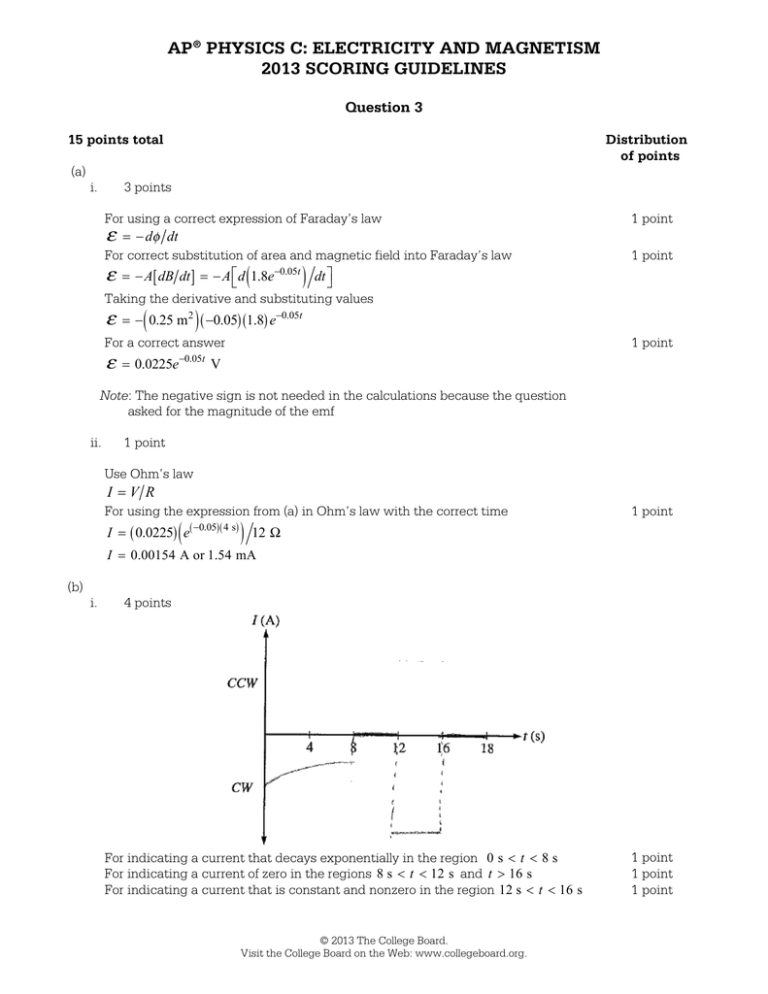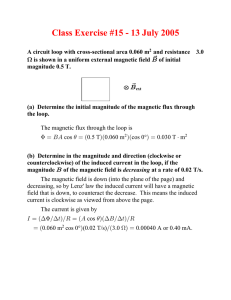e - The College Board
advertisement

AP® PHYSICS C: ELECTRICITY AND MAGNETISM 2013 SCORING GUIDELINES Question 3 15 points total Distribution of points (a) i. 3 points For using a correct expression of Faraday’s law e d f dt For correct substitution of area and magnetic field into Faraday’s law e A dB dt A d 1.8e0.05t dt Taking the derivative and substituting values 1 point For a correct answer 1 point 1 point e 0.25 m2 0.05 1.8 e0.05t e 0.0225e 0.05t V Note: The negative sign is not needed in the calculations because the question asked for the magnitude of the emf ii. 1 point Use Ohm’s law I V R For using the expression from (a) in Ohm’s law with the correct time I 0.0225 e 0.05 4 s 12 W 1 point I 0.00154 A or 1.54 mA (b) i. 4 points For indicating a current that decays exponentially in the region 0 s t 8 s For indicating a current of zero in the regions 8 s t 12 s and t 16 s For indicating a current that is constant and nonzero in the region 12 s t 16 s © 2013 The College Board. Visit the College Board on the Web: www.collegeboard.org. 1 point 1 point 1 point AP® PHYSICS C: ELECTRICITY AND MAGNETISM 2013 SCORING GUIDELINES Question 3 (continued) Distribution of points For indicating a clockwise current in the regions 0 s t 8 s and 12 s t 16 s ii. 1 point 3 points For indicating that magnetic field is decreasing For indicating that an induced magnetic field opposes the change For indicating that the induced current must be clockwise to produce the induced magnetic field 1 point 1 point 1 point Example: The magnetic field is into the page and decreasing. From Lenz’s law, the new current must create a magnetic field to oppose this change. So the new current must create its own magnetic field that is into the page. Thus, according to the right hand rule, the current in the loop must be clockwise. Note: 1 earned point was deducted for any incorrect statements made in conjunction with correct statements. (c) 4 points For indicating that energy is the integral of power over time E Pdt 1 point For using a correct expression of power 1 point E e 2 dt R For a correct substitution from part (a) For using the proper limits on the integration or correctly evaluating a constant of integration 8 E 0 0.0225e0.05t 12 W 2 8 dt 0.0225 2 0.10t e dt 12 W 0 4.22 10 5 0.10 t 8 e E 0.10 0 E 4.22 10 4 e 0.10 8 s e 0 E 2.32 10 4 J © 2013 The College Board. Visit the College Board on the Web: www.collegeboard.org. 1 point 1 point © 2013 The College Board. Visit the College Board on the Web: www.collegeboard.org. © 2013 The College Board. Visit the College Board on the Web: www.collegeboard.org. © 2013 The College Board. Visit the College Board on the Web: www.collegeboard.org. © 2013 The College Board. Visit the College Board on the Web: www.collegeboard.org. © 2013 The College Board. Visit the College Board on the Web: www.collegeboard.org. © 2013 The College Board. Visit the College Board on the Web: www.collegeboard.org. AP® PHYSICS C: ELECTRICITY AND MAGNETISM 2013 SCORING COMMENTARY Question 3 Overview This question probed students’ understanding of electromagnetic induction and assessed students ability to calculate energy dissipation in a circuit with changing current. In part (a), students were given an equation for magnetic field B as a function of time t, and asked to calculate the electric potential induced in a circular circuit of known area and resistance. Students used derived potential functions to calculate the current at a specific time. Because B was exponentially decaying in the time region for which the derivation was requested, calculus was required. In part (b), students sketched a graph of current as a function of time for the entire time period, which included regions where B was exponentially decreasing, constant, decreasing linearly, and zero. Students then justified their graphs by correctly describing the magnetic field behavior and explaining why this behavior resulted in the indicated current direction in terms of the production of the induced magnetic field. In part (c), students calculated the energy dissipated during the time period when the magnetic field was decreasing exponentially. Successful completion of this part of the problem required integration of an expression for power over time, with appropriate substitution of previously derived expressions for current or potential. Sample: E3-A Score: 15 This excellent response received full credit. Part (a) shows a clear derivation of the emf as a function of time, starting with Faraday’s law in part (a)(i) and the subsequent derivation of the current in the loop using Ohm’s law in part (a)(ii). The graph in part (b)(i) received full credit, as does the explanation in part (b)(ii), which is succinct but contains the three necessary statements (field is decreasing, induced field will be into the page, produced by a clockwise current). The small error that flux (a scalar) is “into the page” is ignored. Part (c) is a clear example of the appropriate calculation of the total energy dissipated. Sample: E3-B Score: 10 This response received 2 points in part (a)(i) for using Faraday’s Law and for correct substitution of magnetic field and area. The response loses the third point for failing to derive the correct final expression for emf as a function of time. Full credit was earned in part (a)(ii) for using Ohm’s law with substitution of the value obtained in part (a)(i). Because the student is asked to calculate rather than derive, a completely numeric approach was acceptable. The graph in (b)(i) received 2 out of 4 possible points; 1 for a constant field from 12-16 s and 1 point for zero current where appropriate. The concavity from 1-8 s does not show a decay and the positive current values do not show a clockwise current. The justification in (b)(ii) received 1 point for identifying a decreasing magnetic field, but fails to clearly explain in sufficient detail how this results in the production of the current. Full credit was earned in part (c) for an integral with correct limits of integration and an answer consistent with previous parts. Sample E3-C Score: 5 Part (a)(i) earned 1 point for starting with Faraday’s law and using it in a subsequent step. Part (a)(ii) earned 1 point for substituting the result from part (a)(i) into Ohm’s law. The graph in part (b)(i) earned 1 point for being negative, indicating that the induced current, where it exists, is clockwise. No other points are earned by the graph. In part (b)(ii) the student earned 1 point for identifying that the magnetic field is decreasing, and a second point for indicating that a clockwise current is necessary to produce a © 2013 The College Board. Visit the College Board on the Web: www.collegeboard.org. AP® PHYSICS C: ELECTRICITY AND MAGNETISM 2013 SCORING COMMENTARY Question 3 (continued) field into the page. Because there is no explanation that the induced field must point in that direction to support the diminishing magnetic field, the third point is not earned. No credit was earned for part (c) because although a correct formula for power is written, it is not used in a subsequent calculation. © 2013 The College Board. Visit the College Board on the Web: www.collegeboard.org.



